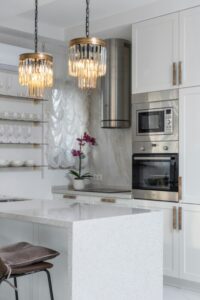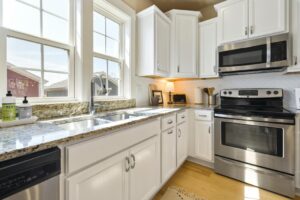Importance of Kitchen Appliances
Kitchen appliances play significant roles in our daily lives. They not only streamline food preparation but also impact cooking efficiency and the quality of food we consume.
Role in Daily Life
From refrigerators that store our groceries to stoves that cook them, kitchen appliances are essential for every household. They help simplify and speed up the food preparation process, making our lives more convenient and efficient.
Impact on Cooking Efficiency
Kitchen appliances help make cooking more efficient by reducing the time and effort it takes to prepare meals. For example, microwaves can quickly reheat leftovers, while food processors can chop ingredients in seconds.
Contribution to Food Quality
High-quality kitchen appliances can improve the overall taste and nutrition value of cooked food. For instance, a high-end oven ensures even cooking, preserving the flavors and nutrients of the food.
Types of Kitchen Appliances
There are two main categories: large and small kitchen appliances. Each has unique features designed for specific functions within your kitchen space.
Large Appliances
Refrigerators
Refrigerators are key components in preserving perishables like fruits, vegetables, dairy products, and more. Modern refrigerators come with advanced features such as temperature control, humidity drawers, and water dispensers.
Ovens
Ovens provide an easy way to bake or roast foods. They come in various types, including conventional, convection, and microwave ovens, each offering different cooking methods to suit various recipes.
Dishwashers
Dishwashers contribute immensely towards cleaning efforts after meals. They save time and water compared to hand washing and come with various settings for different types of dishes and levels of dirtiness.
Small Appliances
Microwaves
Microwaves are essential for quickly reheating food and cooking certain dishes. They offer convenience and speed, making them a staple in most kitchens.
Blenders
Blenders are versatile tools for making smoothies, soups, and sauces. High-powered blenders can even crush ice and blend tough ingredients like nuts and seeds.
Coffee Makers
Coffee makers provide the daily caffeine fix for many people. They range from simple drip coffee machines to advanced espresso makers, catering to different tastes and preferences.
Choosing the Right Kitchen Appliances
To choose suitable kitchen appliances, consider these factors:
Assessing Your Needs
Identify the appliances that are essential for your cooking habits and lifestyle. For example, if you love baking, a high-quality oven should be a priority.
Budget Considerations
Set a budget for your kitchen appliances. Prices vary greatly based on brand, features, and quality. Look for appliances that offer the best value within your budget.
Space and Layout
Consider the available space in your kitchen and how the appliances will fit into the layout. Ensure there is enough room for all appliances without crowding the space.
Energy Efficiency
Energy-efficient appliances can save you money on utility bills and reduce your environmental footprint. Look for appliances with high energy efficiency ratings.
Maintenance and Care
Proper maintenance and care are essential for the longevity and performance of your kitchen appliances.
Regular Cleaning
Clean your appliances regularly to prevent build-up of grime and food particles. Follow the manufacturer’s instructions for cleaning to avoid damaging the appliances.
Periodic Servicing
Some appliances require periodic servicing to maintain their performance. Schedule regular check-ups for appliances like refrigerators and ovens to ensure they are working efficiently.
Repairing Minor Issues
Address minor issues promptly to prevent them from becoming major problems. For instance, replace worn-out seals on refrigerators or fix loose handles on ovens.
Upgrading Old Appliances
Consider upgrading old appliances that are no longer efficient or reliable. Newer models often offer better performance and energy efficiency.
Technological Advancements
Technological advancements have significantly impacted the functionality and convenience of kitchen appliances.
Smart Appliances
Smart appliances can be controlled remotely via smartphones and integrate with home automation systems. They offer features like remote monitoring, automatic adjustments, and voice control.
Energy-Saving Features
Modern appliances come with energy-saving features that help reduce electricity consumption. Look for appliances with Energy Star ratings and other eco-friendly certifications.
Advanced Cooking Functions
Newer appliances offer advanced cooking functions such as air frying, steam cooking, and precision temperature control. These features enhance the versatility and efficiency of your kitchen.
Impact on Lifestyle
Kitchen appliances have a profound impact on our lifestyle by enhancing convenience, saving time, and improving the quality of our meals.
Convenience
Appliances like dishwashers, microwaves, and coffee makers make daily tasks more convenient, freeing up time for other activities.
Healthier Eating
Appliances like blenders, steamers, and slow cookers enable healthier cooking methods, promoting better nutrition and well-being.
Family Time
Efficient kitchen appliances reduce the time spent on meal preparation and cleanup, allowing more quality time with family and friends.
Conclusion
Kitchen appliances are indispensable tools that enhance our daily lives by improving cooking efficiency, food quality, and overall convenience. By choosing the right appliances, maintaining them properly, and staying updated with technological advancements, you can create a kitchen that meets your needs and supports a healthy, efficient lifestyle.
FAQs
Q: What’s the most durable material for kitchen appliances?
A: Stainless steel is typically seen as the most durable material for kitchen appliances due to its resistance to rust and staining.
Q: Is it worth investing in smart kitchen appliances?
A: It depends on your needs and preferences. Smart appliances offer convenience and advanced features but may come at a higher cost.
Q: How often should I clean my kitchen appliances?
A: For daily use kitchens, once a week cleaning is recommended to remove dust and grime build-up. Some appliances, like coffee makers and ovens, may require more frequent cleaning depending on usage.


